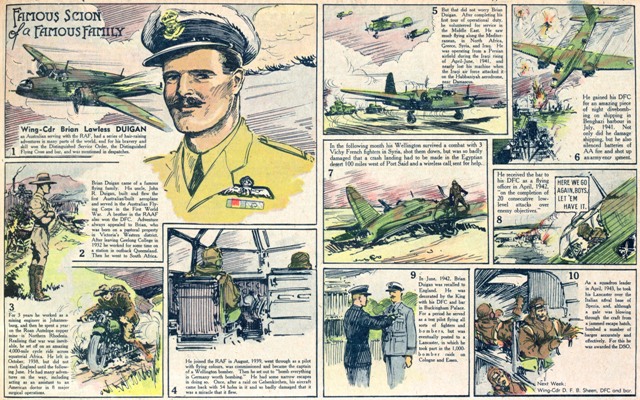DUIGAN, Brian Lawless (1915-1972) DFC DSOBrian Duigan, airman, was the son of the pioneering aviator, Reginald Charles Duigan and his wife Phyllis May nee Peck and, like his brother Terry, first attended Elliminyt State School and Colac High School before attending Geelong College from 1927 to 1932. In 1910 the Duigan brothers Reginald Charles and John Robertson made Australian aviation history when they built and flew the first Australian-made aircraft at Mia Mia, ten miles south-west of Heathcote.
After leaving Geelong College in 1932, Brian worked as a drover on a cattle station in outback Queensland. In 1933, he travelled to South Africa where he worked as a mining engineer in Johannesburg, and then, in 1937, moved to Northern Rhodesia to work at the Hoan Antelope copper mine. In 1938, sensing war was imminent, he undertook a remarkable 4,000 mile motor cycle journey across Equatorial Africa to arrive in England in June 1939.
In August 1939, Brian joined the RAF, gained his 'wings' and as a commissioned officer was assigned to Bomber Command as a pilot in a Vickers Wellington Squadron. At the end of his European 'tour' rather than go home he simply volunteered for a second tour, this time in the Middle East, where he flew in North Africa, Greece, Syria and Iraq. In July 1941, during this second tour, he earned the Distinguished Flying Cross for bravery shown under fire whilst bombing Benghazi harbour. A month later, however, his luck changed and his Wellington was shot down by Vichy French fighters over the Sahara, 100 miles from Port Said, and he had to be rescued. In April 1942, Brian earned a bar to his DFC
'on the completion of twenty consecutive low-level attacks over enemy objectives' , and on returning to England in June 1942, his bar to his DFC was presented personally by King George VI. For six months he acted as a test pilot flying all sorts of aircraft, 'traditional' and 'hush hush', but eventually was posted to a Lancaster Squadron, now as a Wing Commander where he took part in the 1000 bomber raids on Cologne and Essen. In April 1943 he once again eluded the odds and whilst flying a disabled Lancaster on a bombing raid on the Italian naval base of Spezia, he successfully completed the mission and in doing so, won the Distinguished Service Order.
The following letter to his family about a wartime mission was published in Pegasus:
'I flew across Baghdad very low to show the flag, and had a look at Ur of the Chaldees, the celebrated Euphrates and Tigris rivers, and the Dead Sea on the way back. I very nearly came to an untimely end. I was bombing the enemy concentrations around Habbaniyah aerodrome by daylight (during the siege of Habbaniyah in May 1941). I made one trip in the morning, picking up a few bullet holes, and came back in the afternoon for another crack. After using up all my bombs, I came down machine-gunning their positions, and got badly caught in their ground defence. Fifty-eight bullets went through various parts of the machine, one shell tore through the port wing, and another exploded in the fuselage. The petrol tanks were badly holed, and there was a hole almost large enough to crawl through in the port wing. The aerodrome was under machine-gun and shell fire, but as I reckoned I couldn't get home I made a quick landing, and taxied behind a hangar before any more damage was done. The local ground staff got to work, and by 9 o'clock that morning had the machine in more or less fit condition to fly again. This was no mean feat, as the Iraqui army had been spasmodically shelling the area. My crew and I had a most uncomfortable time from 4.30 in the morning until we took off dodging the shrapnel. Thank goodness I'm not in the army! The take off was great fun. A couple of Gladiators circled overhead to keep the Iraq Air Force away, and the armoured cars raced out and around the aerodrome as a diversion and to raise a dust cloud. I shot out from behind the hangar like a bullet, turned through a narrow gap just wide enough to let me through, at about thirty miles per hour, on to the 'drome, and away in a cloud of dust and bullets. I got away all right and returned to the base. We couldn't do much for the machine there. Some of the main members had been shot through in the wing, and the petrol tanks were bad. I had to fill one tank up to a big hole, then drain off some and take a chance in order to leave Habbaniyah. They fixed it up as well as possible, and I flew it back to Egypt for repairs, thus missing the last of the campaign, which was disappointing.' 
Cartoon Story of Brian Duigan, 1943.
Brian married Phyllis Winifred Hales and had two children Virginia and John Lawless. In 1948 Brian returned home to Australia ferrying one of the new English Electric Canberra Bombers. Brian stayed with the RAF after the war and flew jets in Asia and the Middle East, and taught the Shah of Iran to fly. Brian and his family settled in Woodend, Victoria, Australia where he died at the age of 58 in 1972.
Sources: James Affleck, Geelong Collegians at the Second World War. Sources cited by James Affleck-Pegasus; Australian War Memorial; National Archives; John and Reginald Duigan Australian Aviation Pioneers http://ww.ctie.monash.edu.au/hargrave/duigan_bio.html.